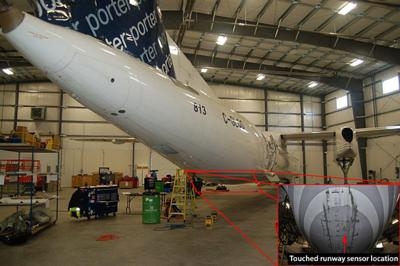Sat, Feb 14, 2015
No Injuries Reported In Incident Involving A Bombardier DHC-8-402
The Transportation Safety Board of Canada (TSB) has released its investigation report (A13O0098) into a May 2013 hard landing and tail strike involving a Porter Airlines Inc. aircraft at the Sault Ste. Marie Airport in Ontario. There were no injuries; however, there was substantial damage to the aircraft.

On 26 May 2013, a Porter Airlines Inc. Bombardier DHC-8-402 flew from the Billy Bishop Toronto City Airport to the Sault Ste. Marie Airport. At 2216 Eastern Daylight Time, during touchdown, the tail struck the runway. After landing, the aircraft taxied to the gate where the passengers were deplaned.
During the final approach to landing, the airspeed began to decrease and the descent rate began to increase. This profile put the aircraft in an unstabilized approach requiring a go-around, but the crew continued with the landing. As the aircraft rapidly approached the runway, instead of increasing engine power to reduce the rate of descent, the pilot pitched the nose up beyond the limits stated in the standard operating procedures and manufacturer's pitch awareness training. The investigation found that the high rate of descent coupled with the high nose-up attitude of the aircraft resulted in the hard landing compressing the struts and allowing the tail to contact the runway.
The investigation also drew attention to the need to clearly define the requirements for a stabilized visual approach, and to clearly define the duties of the pilot monitoring in order to mitigate the risk that unsafe flight conditions could develop.
Immediately following this occurrence, Porter Airlines Inc. initiated an internal investigation as part of its Safety Management System. Part of the immediate corrective action involved a revision of the Pitch Awareness Training highlighting previous occurrences and the need to arrest high descent rates with power and not pitch. The company also conducted a review of training for captains and pilots, reviewed use of flap settings on approach, provided further clarification on the stabilized approach procedure, and re-emphasized hazards associated with night-time operations.
Approach-and-landing accidents are a TSB Watchlist issue. The Board is calling on Transport Canada and operators to do more to reduce the number of unstable approaches that are continued to a landing.
(Image from TSB report)
More News
“Big Things Have Small Beginnings” Set for November 6–8, 2025 at Lakeland Linder International Airport (LAL) in Lakeland, Florida, the first-ever Affordable Flyin>[...]
“Backed by 90 years of Jeppesen’s gold-standard data and ForeFlight’s relentless spirit of exploration, this combination is building the most unified, intuitive p>[...]
“Our strategic partnership with AutoFlight, backed by their substantial technological expertise and tangible advancements in eVTOL airworthiness, represents a significant mil>[...]
Also: Beech M-346N, Metro Gains H160 EMS STC, New Bell Boss, Affordable Flying Expo Tickets NOW On Sale! Purdue University’s Research Foundation and the Archaeological Legacy>[...]
Aero Linx: British Gliding Association (BGA) The British Gliding Association is the governing body for the sport of gliding in the UK and members are the 76 clubs that provide glid>[...]
 1st Annual Affordable Flying Exposition Gets Its Footing
1st Annual Affordable Flying Exposition Gets Its Footing Aero-News: Quote of the Day (11.04.25)
Aero-News: Quote of the Day (11.04.25) Aero-News: Quote of the Day (11.05.25)
Aero-News: Quote of the Day (11.05.25) Airborne 10.30.25: Earhart Search, SpaceX Speed Limit, Welcome Back, Xyla!
Airborne 10.30.25: Earhart Search, SpaceX Speed Limit, Welcome Back, Xyla! ANN's Daily Aero-Linx (11.05.25)
ANN's Daily Aero-Linx (11.05.25)



